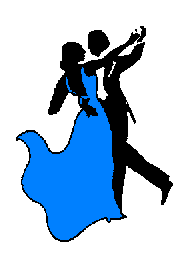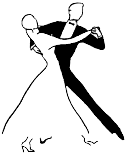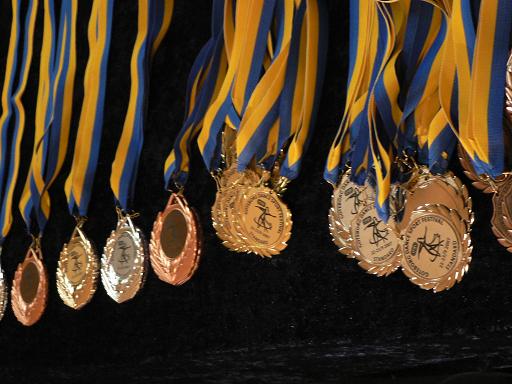|
   |
   |
Om tävlingsdans
För
alla som är nyfikna på tävlingsdans och för de som vill förstå lite
bättre om bakgrund till hur danserna har utvecklas och på vilket sätt
det sociala dansandet och tävlingsdansandet påverkar varandra. Notera
att detta bara handlar om tävlingsdans i Sverige, det är inte samma
tävlingsklasser i andra länder.
|
About competition dancing
For
everyone who is curious about competition dancing and for those who
want to better understand the background to how the dances have evolved
and in what way the social dancing and the competition dancing have
influenced each other. Note that this is about competition dancing in
Sweden, other countries have different competititon classes.
|
Social dans - tävlingsdans
De
flesta danser som lärs ut av mig och på andra dansskolor förekommer
också som tävlingsdanser och det har stor betydelse för hur dansen
dansas socialt.
Nya danser som blir populära är i början
oftast helt oreglerade och ju fler som dansar den desto vanligare är
det att det uppstår nya stilar och varianter.Dessa fanns då inte med i
originalet och finns därmed inte överallt där dansen är populär. Om detta
håller på under en längre tidsperiod kan det bildas helt nya danser som
är väldigt olika originalet. Detta har skett med många äldre danser som t.ex. polka och tango.
När man tar upp en dans till en
tävlingsdans måste man komma överens om hur dansen ska bedömas och då
skrivs det i regel en samling regler för vilka stilar och figurer som
anses vara tillåtna. Detta gör att dansen standardiseras och lärs ut på
samma sätt överallt. Även om man inte vill tävla i dans är detta
praktiskt eftersom det gör att man kan dansa med någon som lärt sig
samma dans någon helt annanstans i världen.
Reglerna för
dansen i tävlingssammanhang kommer efterhand att omfatta detaljerade
beskrivningar av dansteknik, vilket är nödvändigt för att skilja
duktiga par åt men också gör det svårare att lära sig dansen riktigt
bra eftersom det finns mer att lära sig.
Om
dansen fortsätter att dansas socialt, eller börjar dansas socialt igen
efter ett uppehåll, lär man ut dansen med mycket mindre
dansteknik och med mer fokus på att dansen ska funka även på fester,
danskvällar, bröllop och andra sammanhang. Tävlingsdans och social dans
hänger därför nära samman och påverkar varandra i hög grad.
|
Social dancing - competition dancing
Most
dances taught by me and on other dance schools also occurs as
competition dances and that has a great significance for how the dance
is danced socially.
New dances that have become popular, is in
the beginning usually completely unregulated, and the more people who
dance it, the more common is the creations of new styles and
variations. Since these were not included in the original they are therefore
not found everywhere where the dance is popular. If this keeps on
for a long period of time, entirely new dances that are very different
to the original may evolve. This has happened with many older
dances such as polka and tango.
When
a dance is accepted as a competition dance you need to agree on how the
dancers should be judged and then put in print a set of rules for which
styles and figures that are allowed. This means a standardization
of the dance which also means that the dance will be taught in the same way
everywhere. Also if you don't want to compete in dancing, this is
helpful because it helps you to dance with someone who learned the same
dance somewhere else in the world.
The rules for the dance in
the competitions will eventually include detailed descriptions of dance
technique, which is necessary to separate the talented couples, but
also makes it harder to learn the dance really well since there is more
to learn.
If the dance continues to be danced socially, or the
social dancing is started again after a break, the dance is taught with
much less dancing technique and more focus on how to make the dance
work at parties, dance nights, weddings and other occasions.
Competition dancing and social dancing are therefore closely linked and
influence each other greatly. |
Vad är tävlingsdans?
Tävlingsdans
är då alltså när dans förekommer i tävlingssammanhang där
paren / grupperna bedöms utifrån hur bra de dansar och hur väl de
följer
reglerna för dansen. Alla möjliga danser förekommer i
tävlingssammanhang, men framför allt brukar man prata om s.k. tiodans (se
nedan). prata om s.k. tiodans (se
nedan).
Det förekommer även tävlingar i Sverige i danser som inte är lika
standardiserade utan mer sociala, t.ex. i hambo och schottis, men denna
tävlingsform har en lite annan karaktär än i t.ex. tiodans eftersom dessa danser fortfarande i första hand dansas socialt.
Det är framför allt i tiodanserna det förekommer dansare som tävlar på elitnivå och kan leva på sporten. |
What is competition dancing?
Competition
dancing is then when dancing occurs in competitions where the
couples / groups are judged from how well they dance and how well
they follow the rules of the dance. All kinds of dances occur in competitions, but most of all the so-called ballroom dances (see below). kinds of dances occur in competitions, but most of all the so-called ballroom dances (see below).
There
are also competitions i Sweden in dances that are less standardized, but
more social, such as the Hambo and Schottische, but this form of
competition has a slightly different character than in eg ballroom
dancing since these dances still are danced socially in the first place.
It is above all in the ballroom dances that you find dancers who compete at the elite level and can live on the sport. |
Inom vilka danser kan man tävla?
Dessa danser räknas som tävlingsdanser av Svenska danssportförbundet:
- Tiodans,
består av de tio danserna i internationell standard och internationell
latin. De tio danserna består av de fem standarddanserna (modern vals,
slowfox, quickstep,
wienervals och europeisk tango) och de fem latindanserna (cha cha,
rumba, samba, jive och paso doble). Man kan tävla både i tiodans eller
i en av grenarna standard eller latin.

- Bugg och rock n'rolldanser (BRR):
bugg, dubbelbugg, lindy hop, rock n' roll, boogie-woogie, samt disco swing och
mixing blues som bara finns på vissa dansskolor. Dessa danser har en friare struktur med mer improviation,
mindre strikt teknik och inom vissa danser också en del akrobatik.
- Salsa. Är ganska ny som tävlingsdans än så länge.
- Dessutom kan man tävla i disco, både som ensam, parvis och i grupp, och i en del liknande danser där man dansar ihop utan dansfattning, t.ex. line dance.
|
In which dances may you compete?
These dances count as competition dances of the Swedish Dance Sport Federation:
- Ballroom dances,
consisting of the ten dances of International standard and
International latin. The ten dances consists of five standard dances
(Modern waltz, Slow foxtrot, Quickstep, Viennese waltz and European tango)
and five Latin dances (Cha cha, Rumba, Samba, Jive and Paso
doble). You can compete both in ballroom dancing or in one of the
branches of standard and latin.

- Bugg and rock n'rolldanser (BRR):
bugg, double bugg, lindy hop, rock n 'roll, boogie-woogie, and disco
swing and mixing blues that are only available at certain dance
schools. These dances have a freer structure with more
improvisation, less strict technique and in some dances also some
acrobatics.
- Salsa. Is fairly new as a competition dance so far.
- In addition, you can compete in disco,
both as a solo, in pairs and in groups, and in some similar dances
where you dance together without holding a partner, such as line dance. |
Fördelar - nackdelar med tävlingsdans
Fördelar:
det är oftast enda sättet att lära sig en eller flera av danserna
riktigt ordentligt och att få fler turer än dansskolorna lär ut på sina
vanliga kurser, man får möjlighet att hålla på med något man tycker är roligt
och att hela tiden bli bättre och bättre, och så kan det vara roligt att tävla också!
Nackdelar:
dansträning på tävlingsnivå kräver mer träning även om man inte satsar
på någon elitnivå och träningen består ganska sällan av att man får
lära sig nya och roliga figurer, det kan vara ganska dyrt med
lektioner, skor, kläder och resor till tävlingar, det kan vara svårt
att dansa tillsammans med en och samma person så mycket.
|
Pros and cons about competition dancing
Pros:
it is often the only way to learn one or more of the dances really well
and get more figures than the dance schools teach on their usual courses, you
get the opportunity to get involved with something you think is fun and
constantly get better and better, and then it may also be fun to
compete!
Cons:
dance training at the competition level requires more training even if
you do not go for any top level and the training rarely consists of
learning new and fun figures, it can be quite expensive with lessons,
shoes, clothes and travels to competitions, it may also be difficult to
dance with one person so much. |
Hur börjar man?
Om man är intresserad av att fortsätta dansa och kanske börja tävla så småningom ska man först se till att man har grundläggande kunskaper i de danser du
behöver. Enklast är att man börjar i en nybörjargrupp på en dansskola
som har
tävlingsgrupper, men om man har lärt sig tillräckligt mycket någon annanstans kan man få
börja direkt i en tävlingsgrupp. Man måste dock vara medlem i en
förening med tävlingsbehörighet och man måste ha en tävlingslicens.
man först se till att man har grundläggande kunskaper i de danser du
behöver. Enklast är att man börjar i en nybörjargrupp på en dansskola
som har
tävlingsgrupper, men om man har lärt sig tillräckligt mycket någon annanstans kan man få
börja direkt i en tävlingsgrupp. Man måste dock vara medlem i en
förening med tävlingsbehörighet och man måste ha en tävlingslicens.
Innan man kan börja träna i
tävlingsgruppen måste man också ha en danspartner. Eftersom man hela
tiden tränar med sin partner och bara undantagsvis byter partner på
lektionerna är det viktigt att man hittar en person som man kommer bra
överens med och som har samma mål med träningen. Det är också en fördel
om det inte är väldigt stor skillnad i längd. Om man inte har en
danspartner finns det forum på nätet där man kan annonsera efter en,
oftast då bland sådana som kanske redan hållit på ett tag och vars
partner slutat.
Man
måste också ha riktiga dansskor och om
man dansar tiodans ska de ha mockasula. Det finns olika skor för
standard och latin, men om man bara vill köpa ett par är det bäst att
köpa skor för standarddans eftersom de är tillåtna i de flesta
sammanhang. Man kan köpa skor på de större dansskolorna, via
Dansbutiken på Vasagatan, eller
beställa över  nätet. Skor för bugg kan ha antingen mocka- eller
gummisula och har lägre klack än i tiodanserna. nätet. Skor för bugg kan ha antingen mocka- eller
gummisula och har lägre klack än i tiodanserna.
Innan
första tävlingen ska man också se till att man har kläder att dansa i
som är tillåtna, men det brukar vara ett mindre problem.
|
How do you get started?
If
you are interested in continuing to dance, and maybe start competing
later on, you should first ensure that you have basic knowledge of the
dances you need. The easiest way is to start in the beginner group
at a dance school that has competition teams, but if you have learned
anywhere else you can get to start directly in a training group. You
need to be a member of a dance society with permission to send dancers
to competitions and you need a competition license. way is to start in the beginner group
at a dance school that has competition teams, but if you have learned
anywhere else you can get to start directly in a training group. You
need to be a member of a dance society with permission to send dancers
to competitions and you need a competition license.
Before
you can start training in a competition training group you must also
have a dance partner.Since you are constantly practicing with the same
partner and only occasionally change partners in class, it is important
to find someone who you get on well with and who have the same goals
with the training. There is also an advantage if there isn't a too
big difference in length. If you don't have a dance partner, there
are forums online where you can seach for one, usually among those
who may have already been training for a while and whose partner have quit.
You
also need to have proper dance shoes, and if you dance ballroom dances
they should have suede soles. There are different shoes for
standard and latin, but if you just want to buy one pair, it is best to
buy shoes for the standard dances as they are permitted under most
circumstances. You can buy shoes in the larger dance schools,
through the shop Dansbutiken at Vasagatan, or order online. Shoes
for bugg may have either suede or rubber soles and have lower heels
than in the ballroom dances. shop Dansbutiken at Vasagatan, or order online. Shoes
for bugg may have either suede or rubber soles and have lower heels
than in the ballroom dances.
Before the first competition you
need also to ensure that you have appropriate clothing, but this
is usually a minor problem. |
Hur går en tävling till?
En
danstävling inom tiodans går till så att det finns ett rondschema där
det står vilka klasser och åldersgrupper som tävlar och där man kan se
när man ska upp på golvet om man själv ska dansa. Om det är mycket folk
kan det förekomma att det blir semifinal och sedan final. För att det
ska bli direktfinal ska det vara max sju par på golvet.
Alla paren
dansar samtidigt och varje dans varar i ungefär en och en halv minut. Om man dansar flera danser följer de i en viss ordning med en
liten stunds paus emellan. Under tiden dansarna dansar blir de
poängsatta av domarna och poängen samlas sedan in och sammanställs till
listor som redovisas i lokalen. Där kan man se om man t.ex. gått vidare
från en semifinal till en final och den slutliga placeringen. När alla
har
dansat är det vanligtvis prisutdelning innan nästa gren börjar.
minut. Om man dansar flera danser följer de i en viss ordning med en
liten stunds paus emellan. Under tiden dansarna dansar blir de
poängsatta av domarna och poängen samlas sedan in och sammanställs till
listor som redovisas i lokalen. Där kan man se om man t.ex. gått vidare
från en semifinal till en final och den slutliga placeringen. När alla
har
dansat är det vanligtvis prisutdelning innan nästa gren börjar. |
How is a competition organized?
A
dance competition within ballroom dancing is organized with a round
chart showing which classes and age groups that compete and where you
can see when you are up on the floor if you yourself are going to
dance. If there is a lot of people, both semifinal and final may
occur. If there are not more than seven couples in the class there will
be a direct final.
All couples dance at the same time and each
dance lasts about one and a half minute. If you dance several
dances they follow in a certain order with a short pause
between. Meanwhile the dancers is dancing they are scored by the
judges and the scores are then collected and compiled into lists that
are published in the hall. There you can see if you have moved on
from a semi-final to a final and you final placement. When all
have danced, there are distribution of prizes before the next
section begins. pause
between. Meanwhile the dancers is dancing they are scored by the
judges and the scores are then collected and compiled into lists that
are published in the hall. There you can see if you have moved on
from a semi-final to a final and you final placement. When all
have danced, there are distribution of prizes before the next
section begins. |
Vill du veta mer?
Mer information om tävlingssystemet, tävlingsklasser, aktuella regler och även kalender för tävlingar finns på Svenska danssportsförbundets webbsida.
|
Do you want to know more?
More information about the competition system, competition classes, current rules and also a calender for competitions can be found on the Swedish dance cooperations webb, unfortunately only in Swedish.
|

Denna sida är en del av Nöjesdansakuten.
©
Nöjesdansakuten, webmaster. Sidan skapad 101201, omgjord 190313, och senast
uppdaterad
190313.
|
|
|